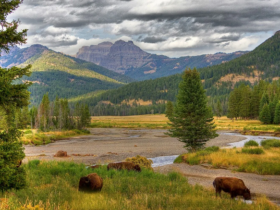Forged elements
Perfection consists of little things, therefore, when landscaping the territory of a private house, you should not miss a single detail, because nothing should violate harmony. For example, a fencing of a site, which cannot be dispensed with, possibly turn into a decoration. This is especially true for forged fences, the openwork lace of which look unusually elegant and at the same time reliable. It is not so easy to move through it, but it does not turn the house into an impregnable fortress.
A variety of forged fences structures.
Forged fences are made of metal rods with a size of 12 × 12 mm, which are installed at a certain distance. There are 3 types: combined, protective and decorative.
Protective fences are highly durable, decorative – created by individual design, and the combined fence combines the artistry and strength of both options.
Stages of the construction of forged fences.
The first stage of construction is a screening of the foundation. Having calculated the right number of sections, mark the area with pillars and lay the traditional foundation (strip or columnar), or install on a pile-screwed basis. Pillars must be installed vertically, and then install fasteners on them.
The next stage is the manufacture of sections. They are created from metal rods. Each section must be formed on a frame made of metal profile. Artistic elements of forging in Tula can be purchased in the blacksmith at: g. Tula, st. Kolitvinova, d. 9 or by phone: +7 (4872) 79-49-14
The final stage of the manufacture of the fence. Having decided on the pattern of sections, it is necessary to mark the location of the elements on the metal profile with chalk. At first, the elements only need to be “grabbed” so that there is an opportunity to adjust. After everything fell into place, you can finally weld everything, and when the fence cools down, it can be prepared for painting.
A variety of forged elements for decorating fences.
Each product poured is consisted of elements that are created separately.
Here are the basic elements of forging:
Balyasin is a column made of metal. Carries the function of support. All buildings using balusters gain strength and reliability.
Voor (or “blacksmithing lace”) looks like the letter “s” with one or two curls. Such forging elements in Tula are often found on the gates of churches.
The insert was created as metal products, giving strength to build, hiding small flaws.
The decorative strip looks like a rectangle made of metal on which the pattern is minted. The pattern is applied using special tools. In the forge you can order such forged elements, and the price on the site will correspond to the quality.
Zhikovina is a door loop decorated with an artistic ornament.
Curl. Its function is the inlaid of products and giving them a picturesque note. They are created only by cold manual forging from smooth steel rods. They are diverse in shape and pattern, however, be sure to bend. Similar forging elements in Tula can be seen on the gates of the 19th century estates.
The plugs are used to prevent corrosion on the product, as they break open places.





